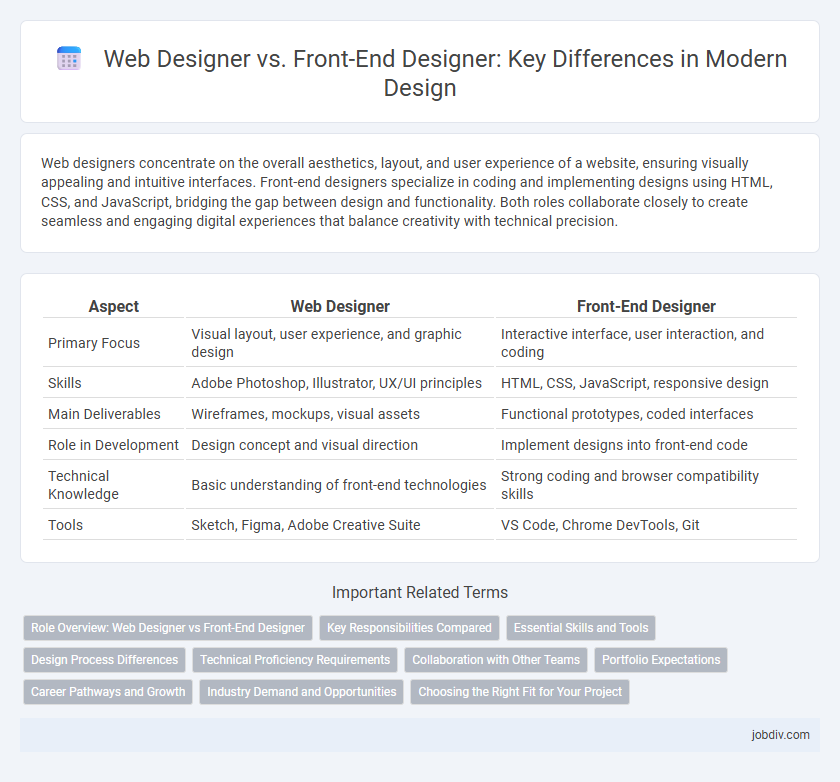Web designers concentrate on the overall aesthetics, layout, and user experience of a website, ensuring visually appealing and intuitive interfaces. Front-end designers specialize in coding and implementing designs using HTML, CSS, and JavaScript, bridging the gap between design and functionality. Both roles collaborate closely to create seamless and engaging digital experiences that balance creativity with technical precision.
Table of Comparison
| Aspect | Web Designer | Front-End Designer |
|---|---|---|
| Primary Focus | Visual layout, user experience, and graphic design | Interactive interface, user interaction, and coding |
| Skills | Adobe Photoshop, Illustrator, UX/UI principles | HTML, CSS, JavaScript, responsive design |
| Main Deliverables | Wireframes, mockups, visual assets | Functional prototypes, coded interfaces |
| Role in Development | Design concept and visual direction | Implement designs into front-end code |
| Technical Knowledge | Basic understanding of front-end technologies | Strong coding and browser compatibility skills |
| Tools | Sketch, Figma, Adobe Creative Suite | VS Code, Chrome DevTools, Git |
Role Overview: Web Designer vs Front-End Designer
Web Designers focus on creating visual layouts, typography, and overall aesthetic appeal of websites, emphasizing user experience and graphic design principles. Front-End Designers specialize in translating design mockups into interactive web interfaces using HTML, CSS, and JavaScript, ensuring responsiveness and functionality across devices. Both roles collaborate closely, with Web Designers prioritizing design concepts and Front-End Designers implementing technical solutions to bring these designs to life.
Key Responsibilities Compared
Web designers focus on creating the overall visual layout, user experience, and aesthetic appeal of websites, often incorporating graphic design and interface elements. Front-end designers specialize in translating these designs into functional, interactive web pages using HTML, CSS, and JavaScript, ensuring responsive and cross-browser compatibility. Both roles require a strong understanding of user interface principles, but front-end designers bridge design and development by implementing code to bring the website to life.
Essential Skills and Tools
Web designers excel in visual aesthetics, mastering tools like Adobe Photoshop, Sketch, and Figma to create appealing layouts and user interfaces. Front-end designers combine design principles with coding expertise, proficient in HTML, CSS, JavaScript, and frameworks such as React or Angular to build responsive and functional websites. Both roles require strong knowledge of UX/UI design, but front-end designers emphasize technical skills for implementation while web designers focus on creative design and prototyping.
Design Process Differences
Web designers primarily concentrate on the visual aesthetics, layout, and user interface elements of a website, ensuring a cohesive and appealing design aligned with brand identity. Front-end designers integrate these visual designs with coding languages like HTML, CSS, and JavaScript to create interactive and responsive user experiences. The design process for web designers emphasizes conceptualizing and wireframing, while front-end designers focus on translating these concepts into functional, user-friendly web pages.
Technical Proficiency Requirements
Web Designers primarily focus on visual aesthetics and user experience, requiring strong skills in graphic design, typography, and color theory, with proficiency in tools like Adobe Photoshop and Sketch. Front-End Designers combine design sensibilities with coding skills, demanding expertise in HTML, CSS, JavaScript, and frameworks such as React or Angular to create interactive, responsive websites. Technical proficiency in both roles is essential, but Front-End Designers must possess deeper knowledge of web development technologies to bridge design and functionality effectively.
Collaboration with Other Teams
Web designers and front-end designers collaborate closely with UX/UI teams, developers, and marketing specialists to ensure cohesive user experiences across digital platforms. Web designers primarily focus on visual aesthetics and layout, requiring frequent input from branding and content teams, while front-end designers translate these designs into responsive, interactive interfaces using HTML, CSS, and JavaScript. Effective teamwork between these roles and product managers accelerates project timelines and enhances usability by aligning design goals with technical feasibility.
Portfolio Expectations
Web Designer portfolios emphasize creativity, user experience, and visual layout skills, showcasing diverse projects that highlight strong graphic design and branding capabilities. Front-End Designer portfolios demonstrate proficiency in coding languages like HTML, CSS, and JavaScript, with interactive web elements and responsive design as key features. Employers expect Web Designer portfolios to reflect aesthetic intuition, while Front-End Designer portfolios must prove technical expertise and seamless integration of design with functionality.
Career Pathways and Growth
Web Designers concentrate on the overall aesthetics, user experience, and visual elements of a website, often utilizing tools like Adobe XD and Sketch to create engaging layouts. Front-End Designers blend creative design skills with coding expertise in HTML, CSS, and JavaScript, enabling them to build responsive, interactive interfaces that enhance user engagement. Career pathways for Web Designers often lead to roles in UX/UI design or creative direction, while Front-End Designers can advance into front-end development or full-stack engineering, reflecting broader technical growth opportunities.
Industry Demand and Opportunities
Web designers primarily focus on visual aesthetics and user interface layout, while front-end designers combine design skills with coding knowledge to build interactive, responsive websites. The industry demand for front-end designers is higher as companies seek professionals who can bridge design and development, optimizing user experience across devices. Career opportunities are expanding faster for front-end designers due to the increasing need for dynamic web applications and the growing complexity of web technologies.
Choosing the Right Fit for Your Project
Web Designers focus on visual aesthetics, user experience, and layout, ensuring the website is attractive and intuitive, while Front-End Designers specialize in coding and implementing interactive elements using HTML, CSS, and JavaScript. Choosing the right fit depends on whether your project prioritizes creative design or technical functionality, with Web Designers best for branding and visual consistency, and Front-End Designers ideal for responsive interfaces and smooth user interaction. Assess project goals and team composition to determine whether a design-oriented or code-centric approach better aligns with your needs.
Web Designer vs Front-End Designer Infographic

 jobdiv.com
jobdiv.com